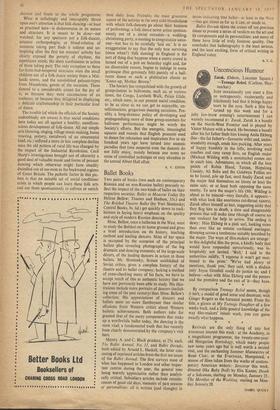Ballet Books
Two pairs of books (two each on contemporary Russian and on non-Russian ballet) precisely re- flect the impact of the two kinds of ballet on their respective societies. Ballet in Moscow Today (by Helene Bellew; Thames and Hudson, 35s.) and The Bolshoi Theatre Ballet (by Yuri Slonimsky; Central Books, 8s. 6d.) get quickly down to rock- battom in laying heavy emphasis on the quality and style of modern Russian dancing.
Mme. Bellew, once a ballerina in the West, went to study the Bolshoi on its home ground and gives a brief introduction on its history, teaching method and leading dancers. Most of her space is occupied by the scenarios of the principal ballets plus revealing photographs of the big dramatic and dancing moments, of the large-scale decors, of the leading dancers in action in those ballets. Mr. Slonimsky, firmest established of Soviet critics, gives a complete history of the theatre and its ballet company; lacking a method of cross-checking many of his facts, we have to accept much of this as authentic history that we have not previously been able to study. His illus- trations include more portraits of dancers (includ- ing some of the past century) than Mme. Bellew's collection. His appreciations of dancers and ballets seem no more flamboyant than similar effusions from Western critics about Western balletic achievements. Both authors take for granted that of the many components that make up a worthwhile ballet today, the dancing is the most vital; a fundamental truth that has recently been clearly demonstrated.by the company's visit here.
Messrs. A. and C. Black produce, at 25s. each, The Ballet Annual, No. 11, and Ballet Decade, both edited by Arnold L. Haskell, the latter con- sisting of reprinted articles from the first ten issues of the Ballet Annual. The first surveys most of what has happened in London and other impor- tant centres during the year, the general tone being warmly appreciative rather than analyti- cally critical. Subsidiary articles include reminis- cences of good old days, memoirs of past seasons or personalities; all is written (and thought) in
terms indicating that ballet—at least in the West —has got about as far as it can, or needs to.
Ballet Decade skims the cream off ten previous issues to present a series of verdicts on the art and its components and its personalities; and many of these have little of truly forensic quality. One concludes that balletography is the least serious, and the least exciting, form of critical writing in England today.


































 Previous page
Previous page